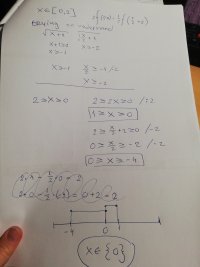this is not correct, so i guess i do not understand.solution 1 = -1
solution 2 = 13/2
final solution [-1,13/2]
You are using an out of date browser. It may not display this or other websites correctly.
You should upgrade or use an alternative browser.
You should upgrade or use an alternative browser.
What am I supposed to do here?
- Thread starter Loki123
- Start date
blamocur
Elite Member
- Joined
- Oct 30, 2021
- Messages
- 3,223
In your post #8 you correctly figured out two intervals, i.e., [imath][0,1][/imath] and [imath][-4,0][/imath], one for each of the two parts of the new functions. As @Steven G pointed out, your new domain contains [imath]x[/imath]s which belong to both intervals so that you can compute both parts.this is not correct, so i guess i do not understand.
that was incorrect #15 is correctIn your post #8 you correctly figured out two intervals, i.e., [imath][0,1][/imath] and [imath][-4,0][/imath], one for each of the two parts of the new functions. As @Steven G pointed out, your new domain contains [imath]x[/imath]s which belong to both intervals so that you can compute both parts.
blamocur
Elite Member
- Joined
- Oct 30, 2021
- Messages
- 3,223
I disagree: both [imath]2x[/imath] and [imath]\frac{x}{2}+2[/imath] must be in [imath][0,2][/imath]that was incorrect #15 is correct
topsquark
Senior Member
- Joined
- Aug 27, 2012
- Messages
- 2,363
We've all but told you the answer to this. There is a simple fact you aren't remembering.solution 1 = -1
solution 2 = 13/2
final solution [-1,13/2]
The domain of f is [0, 2].
So if you are calculating that the domain using (x/2) + 2 then (0/2) + 2 = 2 and (2/2) + 2 = 3 and 2 < 3. What values of x are allowed?
That's as far as I'm prepared to give you hints.
-Dan
hmWe've all but told you the answer to this. There is a simple fact you aren't remembering.
The domain of f is [0, 2].
So if you are calculating that the domain using (x/2) + 2 then (0/2) + 2 = 2 and (2/2) + 2 = 3 and 2 < 3. What values of x are allowed?
That's as far as I'm prepared to give you hints.
-Dan
so here is the thing
i am inclined to say only 2 because of the domain of f you mentioned, however, i am unsure as to why that would be...
we calculated the new domain for new functions.
Steven G
Elite Member
- Joined
- Dec 30, 2014
- Messages
- 14,603
You can compute f of any number between 0 and 2 inclusive. That was given.
Now you can replace x in f(x) with any argument you like but that argument still has the constraint 0 to 2.
If you call the argument 2x, ie if you have f(2x), you can not use x=1.5. Why not? Because 2x would be 3 and you can’t compute f(3) since f(x) is not defunded when the argument is outside of 0, 3.
That is all the help that I can give you.
Now you can replace x in f(x) with any argument you like but that argument still has the constraint 0 to 2.
If you call the argument 2x, ie if you have f(2x), you can not use x=1.5. Why not? Because 2x would be 3 and you can’t compute f(3) since f(x) is not defunded when the argument is outside of 0, 3.
That is all the help that I can give you.
topsquark
Senior Member
- Joined
- Aug 27, 2012
- Messages
- 2,363
Let's try this. For what values of x is (x/2) + 2 in [0, 2]?hm
so here is the thing
i am inclined to say only 2 because of the domain of f you mentioned, however, i am unsure as to why that would be...
we calculated the new domain for new functions.
-Dan
Steven G
Elite Member
- Joined
- Dec 30, 2014
- Messages
- 14,603
I am sorry but what I wrote above is complete nonsense. Sorry about that.I'll do the 1st one for you.
0<x<2. Now double all three terms. This gives you 0<2x<4
I will post the solution since I confused you.
The argument, whatever it is, must be between 0 and 2.
So 0<2x<2 => 0<x<1.
0<x/2 + 2< 2 => -2 < x/2 < 0 => -4 <x <0.
So to compute f(2x) and f(x/2 +2) we need 0<x<1 AND -4<x<0. That means, as you said, x=0
Steven G
Elite Member
- Joined
- Dec 30, 2014
- Messages
- 14,603
Actually, it was incorrect. Sorry.that was incorrect #15 is correct
Okay, thank you!I am sorry but what I wrote above is complete nonsense. Sorry about that.
I will post the solution since I confused you.
The argument, whatever it is, must be between 0 and 2.
So 0<2x<2 => 0<x<1.
0<x/2 + 2< 2 => -2 < x/2 < 0 => -4 <x <0.
So to compute f(2x) and f(x/2 +2) we need 0<x<1 AND -4<x<0. That means, as you said, x=0

